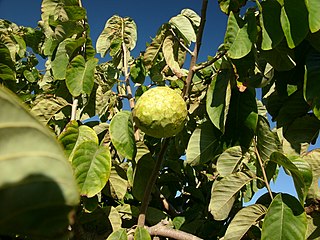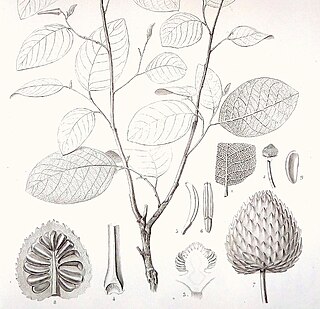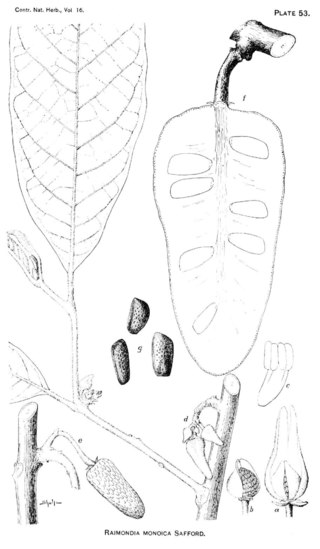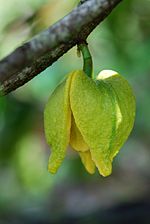
Asimina is a genus of small trees or shrubs described as a genus in 1763. Asimina is the only temperate genus in the tropical and subtropical flowering plant family Annonaceae. Asimina have large, simple leaves and large fruit. It is native to eastern North America and collectively referred to as pawpaw. The genus includes the widespread common pawpaw Asimina triloba, which bears the largest edible fruit indigenous to the United States. Pawpaws are native to 26 states of the U.S. and to Ontario in Canada. The common pawpaw is a patch-forming (clonal) understory tree found in well-drained, deep, fertile bottomland and hilly upland habitat. Pawpaws are in the same plant family (Annonaceae) as the custard apple, cherimoya, sweetsop, soursop, and ylang-ylang; the genus is the only member of that family not confined to the tropics.

The Annonaceae are a family of flowering plants consisting of trees, shrubs, or rarely lianas commonly known as the custard apple family or soursop family. With 108 accepted genera and about 2400 known species, it is the largest family in the Magnoliales. Several genera produce edible fruit, most notably Annona, Anonidium, Asimina, Rollinia, and Uvaria. Its type genus is Annona. The family is concentrated in the tropics, with few species found in temperate regions. About 900 species are Neotropical, 450 are Afrotropical, and the remaining are Indomalayan.

The cherimoya, also spelled chirimoya and called chirimuya by the Inca people, is a species of edible fruit-bearing plant in the genus Annona, from the family Annonaceae, which includes the closely related sweetsop and soursop. The plant has long been believed to be native to Ecuador and Peru, with cultivation practised in the Andes and Central America, although a recent hypothesis postulates Central America as the origin instead, because many of the plant's wild relatives occur in this area.

Annona or Anona is a genus of flowering plants in the pawpaw/sugar apple family, Annonaceae. It is the second largest genus in the family after Guatteria, containing approximately 166 species of mostly Neotropical and Afrotropical trees and shrubs.

Custard apple is a common name for several fruits and may refer to Annonaceae, the custard apple family, which includes the following species referred to as custard apples:

Annona reticulata is a small deciduous or semi-evergreen tree in the plant family Annonaceae. It is best known for its fruit, called custard apple, a common name shared with fruits of several other species in the same genus: A. cherimola and A. squamosa. Other English common names include ox heart and bullock's heart. The fruit is sweet and useful in preparation of desserts, but is generally less popular for eating than that of A. cherimola.

Annona squamosa is a small, well-branched tree or shrub from the family Annonaceae that bears edible fruits called sugar apples or sweetsops. It tolerates a tropical lowland climate better than its relatives Annona reticulata and Annona cherimola helping make it the most widely cultivated of these species. Annona squamosa is a small, semi-(or late) deciduous, much-branched shrub or small tree 3 to 8 metres tall similar to soursop. It is a native of tropical climate in the Americas and West Indies, and Spanish traders aboard the Manila galleons docking in the Philippines brought it to Asia.

Annona glabra is a tropical fruit tree in the family Annonaceae, in the same genus as the soursop and cherimoya. Common names include pond apple, alligator apple, swamp apple, corkwood, bobwood, and monkey apple. The tree is native to Florida in the United States, the Caribbean, Central and South America, and West Africa. It is common in the Everglades. The A. glabra tree is considered an invasive species in Sri Lanka and Australia. It grows in swamps, is tolerant of saltwater, and cannot grow in dry soil.

Annona purpurea is an edible fruit and medicinal plant in the Annonaceae family. It is native to Mexico, Central America, and parts of South America. Its common names include soncoya, sincuya, and cabeza de negro.

Annona montana, the mountain soursop, is a tree and its edible fruit in the Annonaceae family native to Central America, the Amazon, and islands in the Caribbean. It has fibrous fruits. A. montana may be used as a rootstock for cultivated Annonas.

Rollinia is a genus of plants in the family Annonaceae. While it is widely recognised as a distinct genus a monograph published in 2006 advocates its inclusion in Annona, which also contains custard apples and soursops.

Annonacin is a chemical compound with toxic effects, especially in the nervous system, found in some fruits such as the paw paw, custard apples, soursop, and others from the family Annonaceae. It is a member of the class of compounds known as acetogenins. Annonacin-containing fruit products are regularly consumed throughout the West Indies for their traditional medicine uses.

Acetogenins are a class of polyketide natural products found in plants of the family Annonaceae. They are characterized by linear 32- or 34-carbon chains containing oxygenated functional groups including hydroxyls, ketones, epoxides, tetrahydrofurans and tetrahydropyrans. They are often terminated with a lactone or butenolide. Over 400 members of this family of compounds have been isolated from 51 different species of plants. Many acetogenins are characterized by neurotoxicity.

Annona senegalensis, commonly known as African custard-apple, wild custard apple, wild soursop, abo ibobo, sunkungo, and dorgot is a species of flowering plant in the custard apple family, Annonaceae. The specific epithet, senegalensis, translates to mean "of Senegal", the country where the type specimen was collected.

Annonamine is a benzylisoquinoline alkaloid isolated from Annona muricata, a plant commonly used in folk medicine by indigenous communities in Africa and South America. Structurally, it contains an aporphine core featuring a quaternary ammonium group.

Annona bullata is a species of plant in the family Annonaceae. It is native to Cuba. Achille Richard, the French botanist who first formally described the species, named it after the bubbled appearance of the spaces between the fine network of veins in the leaves.

Annona crassivenia is a species of plant in the family Annonaceae. It is native to Cuba. William Edwin Safford, the American botanist who first formally described the species, named it after the thick tertiary veins that interconnect the secondary veins of its leaves.
Annona stenophylla is a species of plant in the family Annonaceae. It is native to Tanzania and Zambia. Adolf Engler and Ludwig Diels, the German botanists who first formally described the species, named it after its narrow leaves.

Annona cherimolioides is a species of plant in the Annonaceae family. It is native to Colombia and Ecuador. José Jerónimo Triana and Jules Émile Planchon, the botanists who first formally described the species, named it after its resemblance to another Annona species A. cherimoya.





















